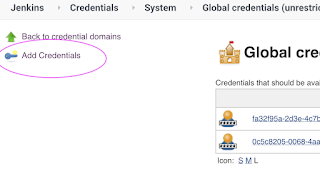We will learn how to create CICD pipeline to deploy springboot microservices using Jenkins pipeline into EKS Cluster with help of Kubernetes CLI plug-in.
We will use Springboot Microservices based Java application. I have already created a repo with source code + Dockerfile. The repo also have Jenkinsfile for automating the following:
- Automating builds using Jenkins Pipeline
- Automating Docker image creation and tagging
- Automating Docker image upload into AWS ECR
- Automating Docker Containers Deployments to Kubernetes Cluster
- Automating Docker image creation and tagging
- Automating Docker image upload into AWS ECR
- Automating Docker Containers Deployments to Kubernetes Cluster
Watch steps in YouTube channel:
Same Code for this video is here:
Make sure you fork my repo https://github.com/akannan1087/springboot-app
Pre-requisites:
1. Amazon EKS Cluster is setup and running. Click here to learn how to create Amazon EKS cluster.
1. Amazon EKS Cluster is setup and running. Click here to learn how to create Amazon EKS cluster.
5. Docker, Docker pipeline and Kubernetes CLI plug-ins are installed in Jenkins
Step # 1 - Create Maven3 variable under Global tool configuration in Jenkins
Step #2 - Create Credentials for connecting to Kubernetes Cluster using kubeconfig
Click on Add Credentials, use Kubernetes configuration from drop down.
use secret file from drop down.
execute the below command to login as jenkins user.
sudo su - jenkins
you should see the nodes running in EKS cluster.
kubectl get nodes
Create namespace to deploy the containers
kubectl create namespace springboot-app-ns
kubectl get ns
Execute the below command to get kubeconfig info, copy the entire content of the file:cat /var/lib/jenkins/.kube/config
Step # 3 - Create a pipeline in Jenkins
Step # 4 - Copy the pipeline code from below
Make sure you change red highlighted values below as per your settings:
Your docker user id should be updated.
your registry credentials ID from Jenkins from step # 1 should be copied
Make sure you change red highlighted values below as per your settings:
Your docker user id should be updated.
your registry credentials ID from Jenkins from step # 1 should be copied
pipeline {
tools {
maven 'Maven3'
}
agent any
environment {
registry = "account_id.dkr.ecr.us-east-1.amazonaws.com/coachak/my-docker-repo"
}
stages {
stage('Cloning Git') {
steps {
checkout([$class: 'GitSCM', branches: [[name: '*/main']], doGenerateSubmoduleConfigurations: false, extensions: [], submoduleCfg: [], userRemoteConfigs: [[credentialsId: '', url: 'https://github.com/akannan1087/springboot-app']]])
}
}
stage ('Build') {
steps {
sh 'mvn clean install'
}
}
// Building Docker images
stage('Building image') {
steps{
script {
dockerImage = docker.build registry
dockerImage.tag("$BUILD_NUMBER")
}
}
}
// Uploading Docker images into AWS ECR
stage('Pushing to ECR') {
steps{
script {
sh 'aws ecr get-login-password --region us-east-1 | docker login --username AWS --password-stdin account_id.dkr.ecr.us-east-1.amazonaws.com'
sh 'docker push account_id.dkr.ecr.us-east-1.amazonaws.com/coachak/my-docker-repo:$BUILD_NUMBER'
}
}
}
// Avoid latest tag image and pass build ID dynamically from Jenkins pipeline
stage('K8S Deploy') {
steps{
script {
withKubeConfig([credentialsId: 'K8S', serverUrl: '']) {
echo "Current build number is: ${env.BUILD_ID}"
// Replace the placeholders in the deployment.yaml file
sh """
sed -i 's/\${BUILD_NUMBER}/${env.BUILD_ID}/g' eks-deploy-k8s.yaml
"""
sh ('kubectl apply -f eks-deploy-k8s.yaml -n springboot-app-ns')
}
}
}
}
}
}
Step # 5 - Build the pipeline
Step # 6 - Verify deployments to K8S
kubectl get deployments -n springboot-app-ns
kubectl get services -n springboot-app-ns
If you see any errors after deploying the pods, you can check the pod logs.
kubectl logs <pod_name> -n spring-app-ns
Steps # 7 - Access SpringBoot App in K8S cluster
Once build is successful, go to browser and enter master or worker node public ip address along with port number mentioned above
http://loadbalancer_ip_address
You should see page like below:
Note:
Make sure you fork my repo https://github.com/akannan1087/springboot-app
and make changes in eks-deploy-k8s.yaml to pull Docker image from your AWS ECR repo.



















No comments:
Post a Comment